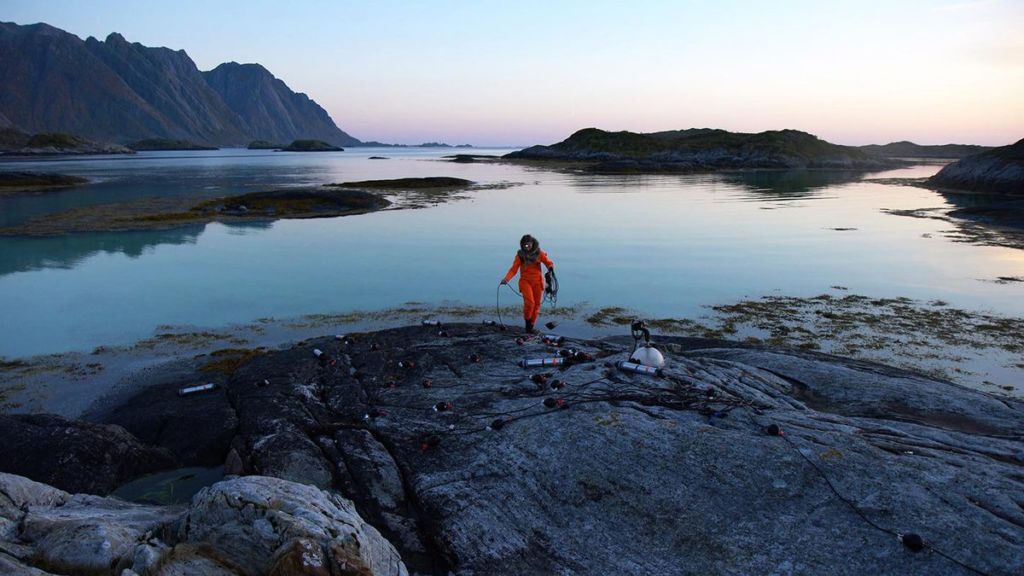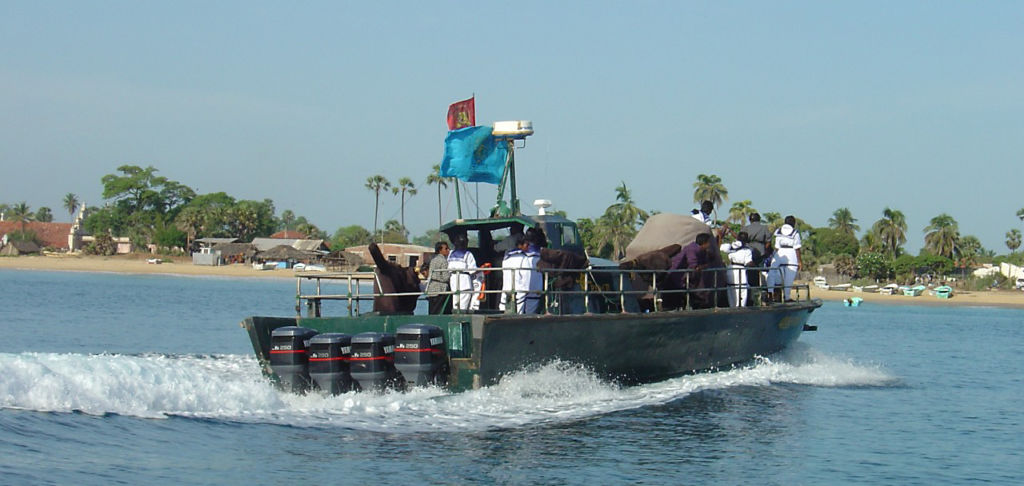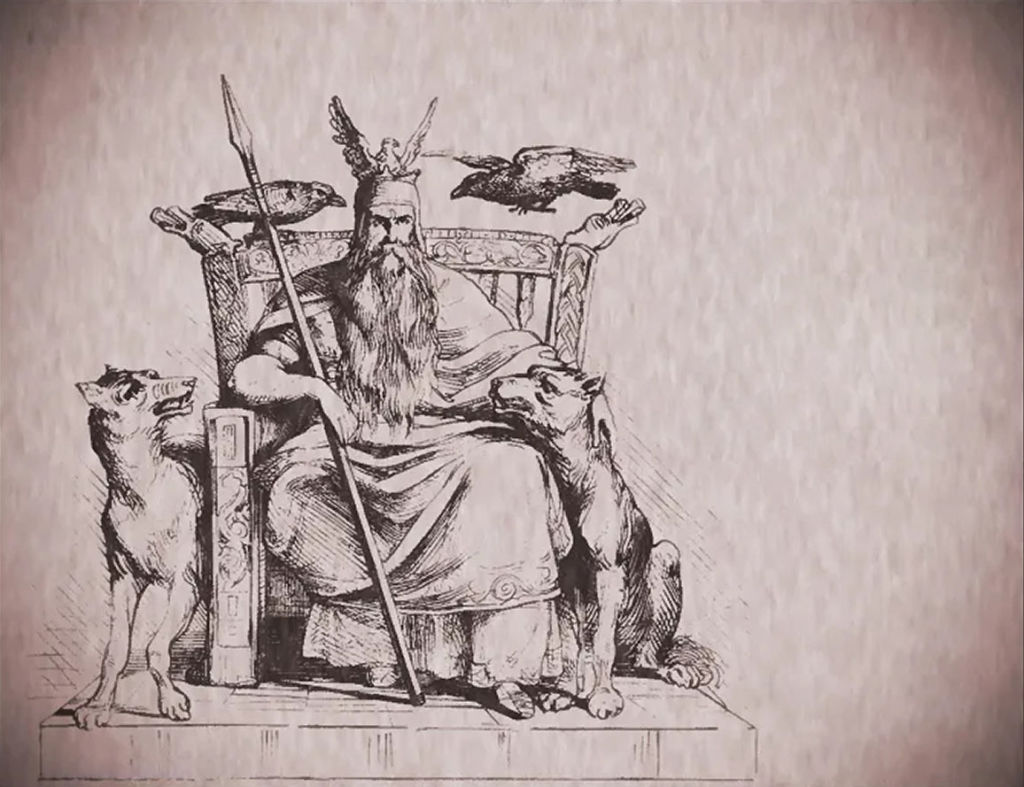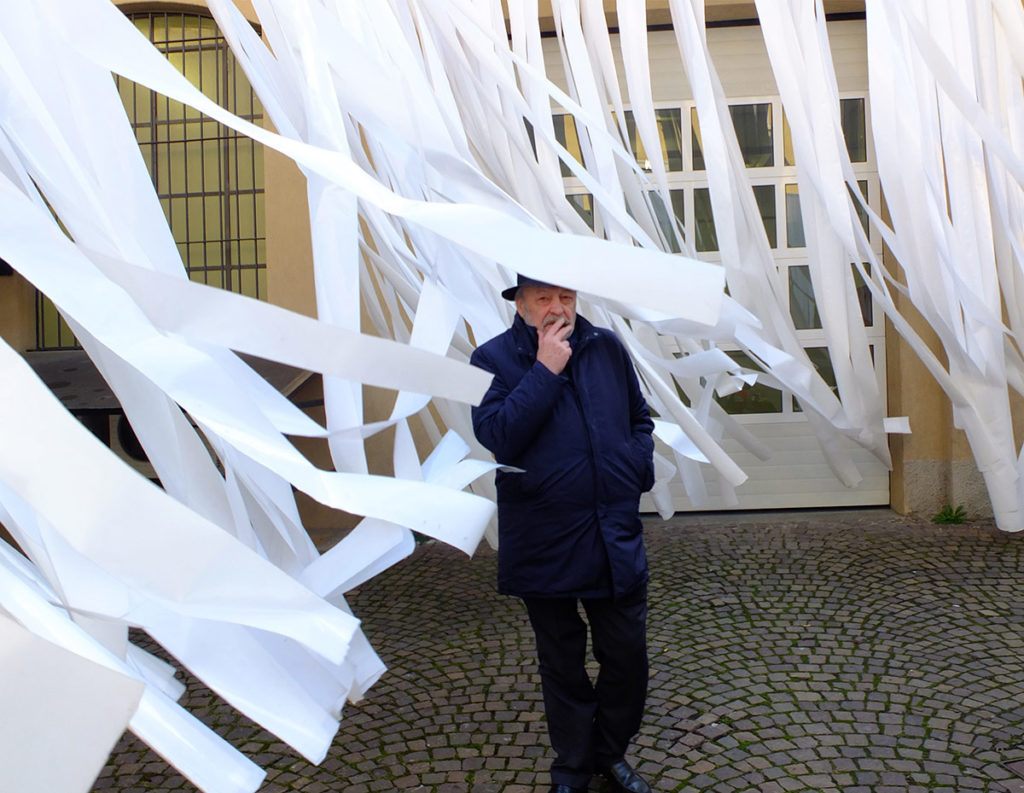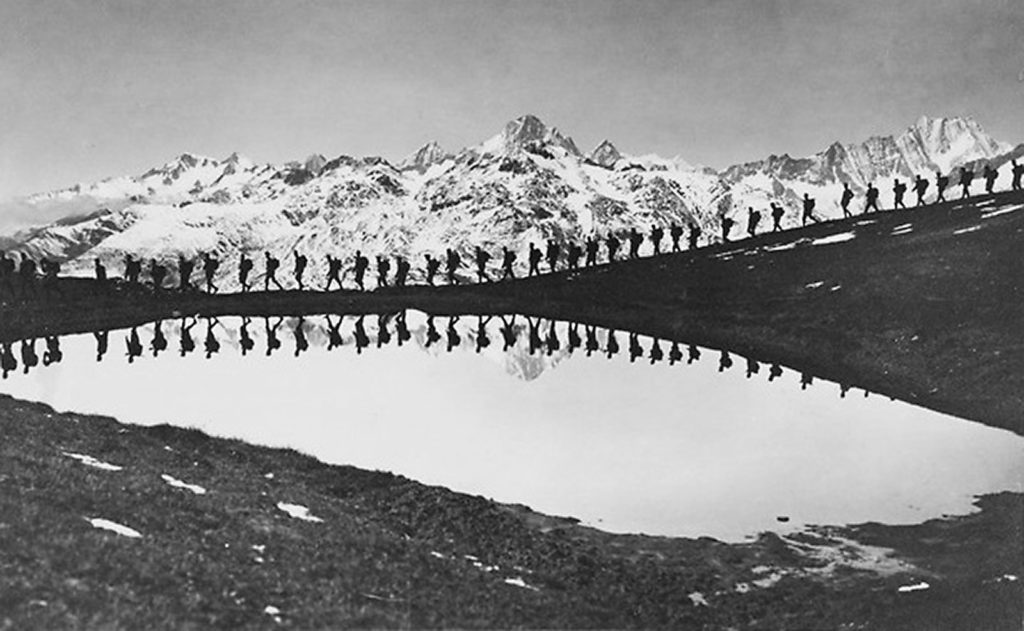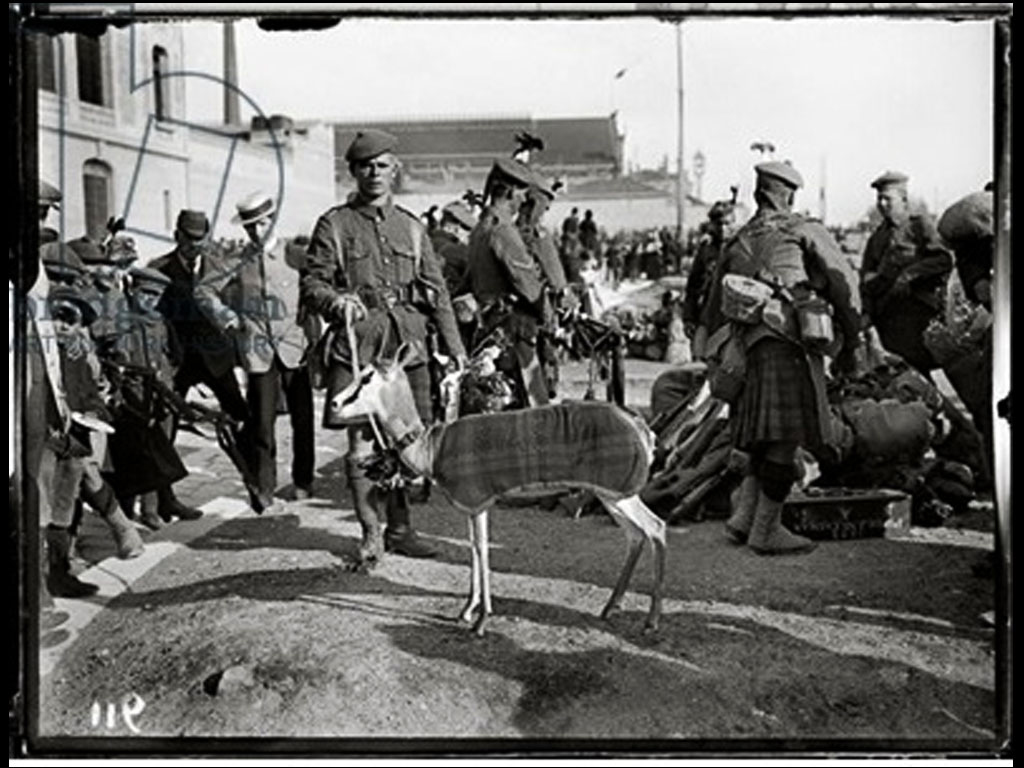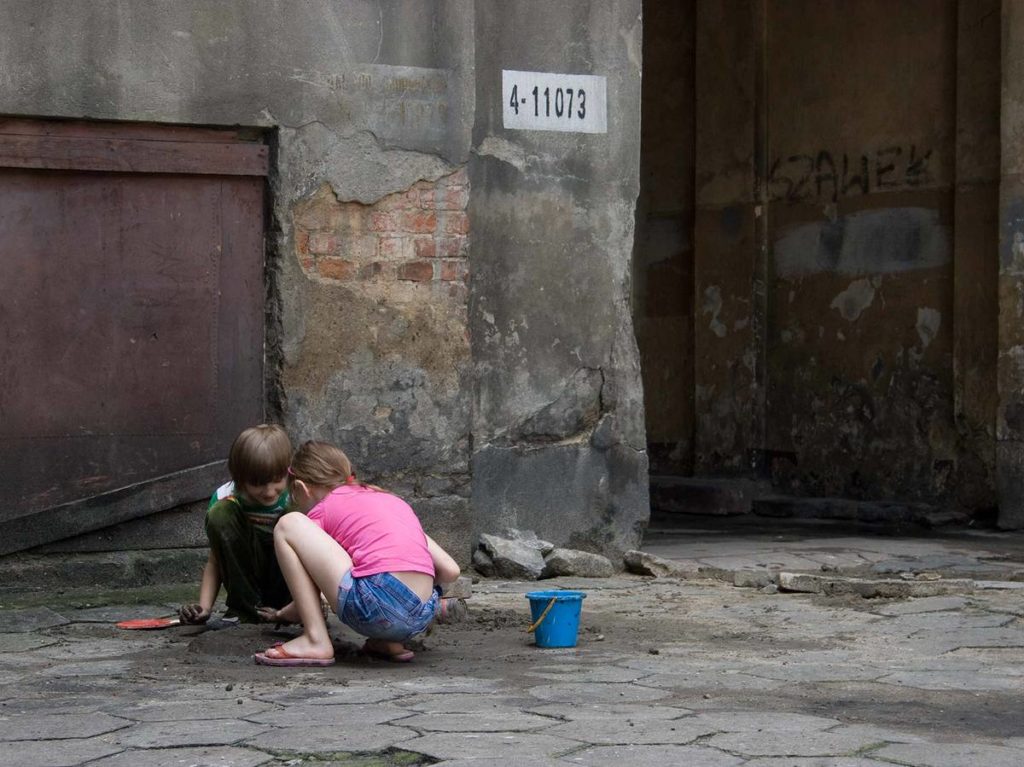For more than twenty years, through her video essays, Swiss artist and writer Ursula Biemann has been addressing contemporary ecological challenges – mass extractivism, unequal access to natural resources… – as well as migration flows, or the consequences of human pressure on the environment and on life as a whole. More than ever, current events confirm the relevance of her complex vision, connecting the voracious exploitation of resources and irreversible transformation of soils and entire ecosystems to the social and environmental issues we face.
Highly knowledgeable about cutting edge scientific research as well as philosophical and anthropological debates on ecological issues, the artist instils eco-feminist perspectives into her filmic work, where feminist and ecological approaches come together to rise against the over-exploitation of nature and the commodification of life, and to promote actions of repair. She celebrates the inclusion of cosmological representations in international law and gives voice to non-human perspectives – in other words, she takes into account the ways of thinking of other living forms.
Far from giving in to today’s climate of doom and gloom, Ursula Biemann invites us to reconnect to our roots in the natural order and listen to those peoples who live in a rich and respectful relationship with the non-human. This interview looks back on some of her key works since 2012 – on the intellectual, anthropological and scientific issues they raise and her study of the figure of the indigenous scientist.
Hélène Guenin: Ursula, at the end of the 1990s, you initiated a series of video essays exploring contexts and issues of mobility, migration, the places of tension or mechanics of alienation that crystallize at global north-south borders as in Performing the Border (US-Mexico) or Europlex (Spain-Morocco). Very quickly you highlighted the geographies of exploitation, correlating human domination, extraction of natural resources and inequality in their redistribution as in Black Sea Files. Starting with Egyptian Chemistry (2012), and more precisely Deep Weather (2013), this research took a new turn by shifting from elaborating on the complexity of the relationship between a territory and its resources towards more openly ecological issues: the impact of our actions on ecosystems. Can you describe how this transition from the “cartographic”, geopolitical and social, to the ecological approach occurred?
Ursula Biemann: I’m surely not suggesting that the geopolitical and the environmental domains are unrelated. On all of my field trips, I have observed the unbridled devastation of the environment as a result of the mindboggling acceleration and expansion of global capitalism. Even on my very first field trip to Ciudad Juarez on the US-Mexico border, where the northern digital industries established the hundreds of cheap labor assembly plants drawing in a massive female labor force from poor Mexican provinces, the contamination of soils and water by the lawless corporate operations was blatant. It was simply the choice of setting my priorities on topics that were theoretically far more interesting to me at the time, which was the simultaneous generation of border and gender within the geography of global labor, in other words, the emergence of a particular gendered subject that was driving this new world order.
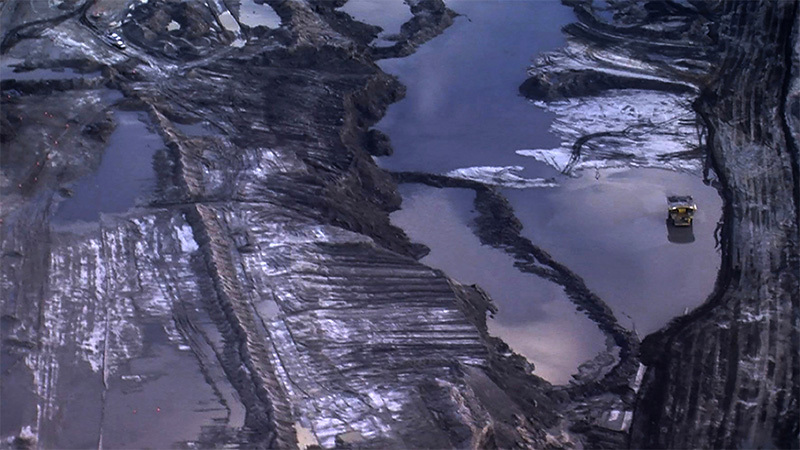
Ursula Biemann
Deep Weather, 2013
Another aspect, which made it into the title of this video essay, is the performativity of the border as a symbolic place that needs to be constantly reproduced by these gendered bodies in order to maintain its meaning. That’s when I understood that my own action in the field became part of this performance of space-making, it was by no means simply a task of representation. This is what signifies a geographic practice to me, a symbolic form of redesigning space. Following these gendered bodies around the world as they migrated to the global assembly lines and the blooming sex industry made me a witness of the impressive magnitude of the exploitation. I was interested in composing a visual construct bringing feminist theory into conversation with new discourses on mobility and technology. This was followed by a series of works that attempted to understand the rapid transformation of European borders as a result of the Schengen agreement, through the tracing of a complex system of trajectories across the Sahara and from post-Soviet territories.
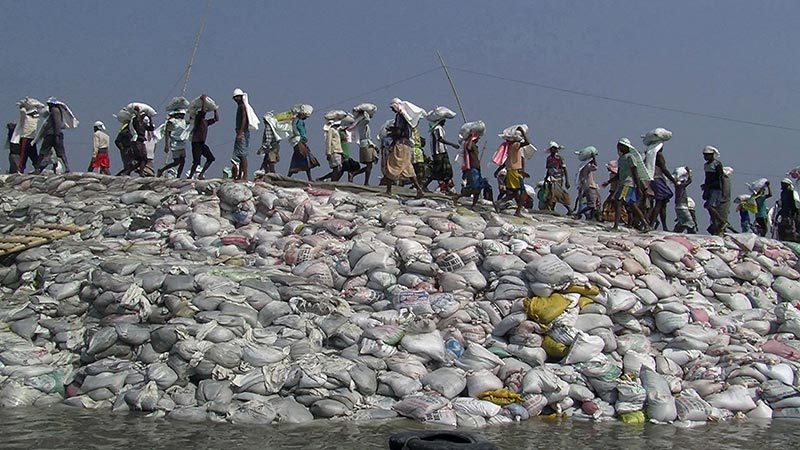
Ursula Biemann
Deep Weather, 2013
I never focused too much on individual stories, I took a systemic approach to these phenomena. In this and many other ways, my video essays distinguish themselves from a journalistic approach. Geography was simply an aesthetic tool to understand the transforming world. Come 2010, however, it became clear that this surface image of the world had become insufficient. The damage had been seeping into the earth for decades, into the water, the air, it entered all living bodies. The catastrophe had penetrated the condition of life on earth. We need to open up to a planetary consciousness as we enter a phase where every decision we take has decisive consequences for our future. Naturally I focused on locations where the environmental crises was clearly visible. But ecology as a living assemblage of interactive organism also lent itself well as a way of structuring the narrative. The kinds of ecologies I created in and through my videos included natural as well as social and technological elements. After all, they are not an expression of a nostalgic desire to return to a pure natural environment.
HG: In Deep Weather, you offer a striking parallel between two geographies, two catastrophic and intimately linked ecological situations resulting from profound transformations in nature and climate. In particular, you film the tar sands mines in northern Canada, which are encroaching heavily on the region’s forests, spreading their black pollution over the wilderness, destroying Alberta’s wildlife, and contaminating the soil and water over the long term. These images of disturbing beauty then give way to those of the construction of a dyke in Bangladesh, where the melting Himalayan glaciers, rising sea levels and extreme climatic conditions force the population into an amphibian life and a permanent struggle for survival. Through this geographical confrontation, the film embodies the unsuspected repercussions of the massive exploitation of resources and the unpredictable future shaped by our actions on the other side of the world. In addition, you introduce a dimension – that seems very important to me – to what could remain circumscribed to the order of observation: a whispered narrative, a very chiseled writing, which gives this film a dimension of a tale of today, magnificent and terrible, introducing the idea of a narrator who might have the capacity to have a meta-vision on the scale of the globe. Can you share with us on the stakes of this choice, which seems to me to herald the shift towards fiction that we find in your most recent works. Can you also go back over the choice of confronting these two geographies?
UB: I have never seen devastation on such a scale. The toxic waste produced by the processing of bitumen is stored in open tailing lakes spreading over vast areas which until recently were covered by ancient spruce forests. Aggressive mining, steam processing, and the trucking around of the tar sands all impinge on environmental and human rights as they destroy the living space and hunting territories of First Nations communities. But for the Cree First Nation who are living in the Athabasca region, the damage reaches beyond blocking traditional knowledge and hunting practices. Local mythologies and divinities animate their land. The landscape contains both worlds, it is a psycho-social habitat. The noise, subterranean sonar waves and vibrations, and the invisible toxic juices seeping into lakes and rivers affect not only the biological but also the psychic ecology of contamination. While the Cree community is absent in the images, the legendary quality of their collective space teetering on the brink of disaster is evoked in Deep Weather in the whispered voice-over: “The wildlife has retreated / the traplines are empty / the elders call the spirits / the young ones sing rap songs / and the acid wind’s hissing / Evolution isn’t fast enough. Mutate!” The whisper, which resonates with the aerial video footage, activates a time-space beyond the immediate physical and political reality. You are absolutely right in saying that this is a shift in my approach in that the voice-over invokes a science-fictional narrative.
Set in times of epic geological, chemical, and hydrological disorder, the situation seemed to require this gesture. The voice enters the atmospheric chemistry which carries the toxic particles across the globe. The whisper also makes it more corporal somehow, it compensates the absence of the bodies to some extent. On the other side of the globe, in the second part of the video, the frame is filled with people who work with their bare hands, without any machines, to build these mud embankments. In both geographies, it is a manipulation of mud. But the two geographies express radically different perspectives and attitudes toward the Earth. In Canada, the aggressive extraction of heavy fuel, large machinery and the vertical desire of extraction into the depths of time; in Bangladesh, the drowning of communities of the delta, the manual labor of millions, and the submerged expansion into the horizontality of a rising ocean. As Canada strives for exhaustive accumulation, I got a sense in Bangladesh that they invest in a future, however precarious it may be. What this comparison makes evident is that climate change is also, first and foremost, a matter of justice.
HG: About those justice issues, I would like to mention Forest Law (2014), which is an emblematic piece and a pivotal moment in your work on ecological issues. This film was shot in the rain forests of Ecuador, in one of the richest regions of the planet in terms of biodiversity and minerals. A highly coveted territory that is subject to strong pressure from oil companies and exploitation that has led to a deep degradation of the soil and water, contaminated by hydrocarbons, and therefore of the living conditions of the inhabitants. You have decided to film this territory and give voice to indigenous leaders, jurists, and scientists who have sued oil and mining companies in order to get recognition of this serious attack on biodiversity and to obtain reparations and soil remediation. In particular, the Sarayaku people are mentioned, who for the past 25 years have become a figure of resistance. Their defense system was notably based on the central dimension of a “living forest” cosmology, vital for the survival of the community. Can you talk about how you approached the shooting and the fieldwork you carried out?
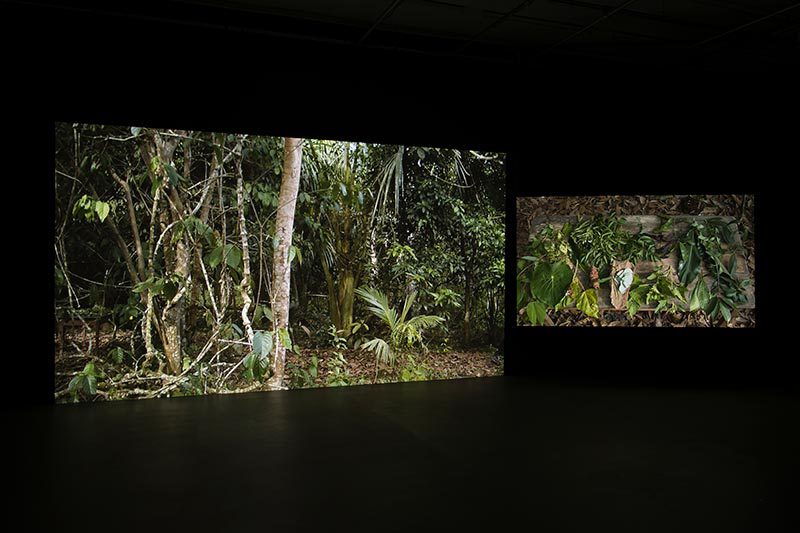
Ursula Biemann & Paulo Tavares
Forest Law, 2014
UB: In How Forests Think, Eduardo Kohn places human anthropology in a larger semiotic context of thinking selves, which includes all beings and their form-giving lives, i.e., all semiosis, but also other beings, such as spirits of ancestors and the masters of the forest, the protectors of the ecosystems, with whom the shamans communicate. He developed these beautiful theories at a Kitchwa village located near the Sarayaku territory where we did our fieldwork in the Amazon. In widening the semiotic concept, Kohn succeeds in going beyond an anthropology of the human, connecting Donna Haraway with Viveiro de Castro. This thorough and delightfully creative theory was helpful for Forest Law in that it offered a scientific proposal for some of the less tangible arguments that indigenous leaders brought before the Inter-American Court of Human Rights against the intrusion of oil companies in their territories. José Gualinga, the leader of the Sarayaku people at the time, speaks about the living forest as the forest of beings, a place where the micro- and macro-organisms communicate with each other and with the community. It’s very easy to dismiss these cosmological visions as premodern or simply mythic; the real task however is to begin to seriously incorporate them into our thinking, which has been dominated by exclusionary rational formats to the detriment of the planet and its life systems. Kohn’s interpretation of the thinking forest is an extraordinary contribution. For Forest Law we were generally concentrating on forest-related legal cases in Ecuador, a country that stands out as a global epicenter for this kind of environmental activism. Sarayaku was one of the key areas of interest to us, but it was difficult to access. The village council decides on each and every visitor who can enter the territory. Making a previous personal contact with activist Franco Viteri paved the way for us to fly to Sarayaku on this tiny propeller plane and interview him, as well as José Gualinga, whose testimony turned out to be crucial to the video and the book.
HG: Forest Law also highlights the importance of “indigenous knowledge” and the “indigenous scientist,” a figure of reconciliation between indigenous ancestral knowledge and western academia. It is a figure that is also found in Acoustic Ocean, a film shot in the Lofoten Islands, in Norway, in which you portray the character of a young scientist of Sami origin (played by composer, singer and environmental activist Sofia Jannok), a semi-nomadic indigenous people living in the north of Norway, Finland, Sweden and Russia. The “indigenous scientist” is becoming an increasingly important presence in your work. The knowledge accumulated and transmitted over generations, inscribed in a deep relationship with the territories, has long been despised and ignored, reflecting a colonial history but also an ideology of progress. Today it is gradually being reconsidered, to such an extent that you mention in an interview that: “The scientist plays a role that is equally important, and stands as signifier of, our own moment, as did the worker in the social transformations of the twentieth century, or the migrant since the onset of globalization. This “indigenous scientist” would therefore be for you the new paradigmatic figure of the beginning of the 21st century?
UB: For artists, there is the challenge of dealing with the fact that, on the one hand, the modern sciences have been rightfully critiqued by postmodern and postcolonial scholars as instruments of power that can foster myths of objectivity, neutrality, etc.; and, on the other hand, that science is essential to underpin environmental and climate justice. My videos document real and fictional scientists who perform scientific acts, use scientific instruments, and aspire to scientific rigor, but are, at the same time, field workers embedded in complex ecosystems, working from uncertain positions and characterized as political actors. I’m interested in the indigenous scientist because I see him or her as the ultimate radical figure that has the capacity of merging these contradictions. Remember that with the rise of modern, Western thinking, humans’ relationship with nature was delegated to the natural sciences, which included the indigenous being cast as objects of research but never as acting subjects who could enter the socio-political sphere. Hence, positing the indigenous person not only as a political subject owning a voice and a territory, but also, more scandalously, as a knowledge-producing scientist, gets to the core of the current problem wherein extractivist claims, based on the logic of Property Rights, are clashing with a very different concept of nature lived by indigenous people around the world. Their epistemology and massive reservoir of knowledge must begin to play a more central role in shaping our human-Earth relations. Helping to facilitate this direction is the way I wish to go forward from here.
HG: I’d like to talk about a new, very ambitious and highly stimulating project that you embarked on in 2018, that of an Indigenous University, conceived on the invitation of the Museum of Contemporary Art in Bogotá and the Inga peoples in Colombia. This long-term project is a very concrete way of building a possible way forward, of preserving ancestral knowledge and ways of life that respect and protect their ecosystems, but also of reconciling two hitherto opposing forms of knowledge: empirical, situated knowledge versus Western, abstract knowledge. It is also a way of trying to go beyond a colonial history… Can you tell us about the major issues of this “Devenir University” and your role in this adventure?
UB: To my own surprise, I have become involved in actively collaborating on the foundation of a new indigenous university in the post-conflict Amazonian region of Colombia. I was introduced to the idea during a field excursion to Nariño and Putumayo in the Amazon, where I had extended meetings with indigenous leaders. Ultimately, I became convinced that in this context, it makes more sense to co-create an institution that will help facilitate indigenous sciences in the years to come than to create another video about the pressures on indigenous territories and their vital forests. The preservation of ancestral knowledge of the specific ecologies of the rain and cloud forests and the foggy high moors of the paramos is absolutely vital for the subsistence of the forests and the communities who inhabit them. The epistemological and biological diversity of these forests are equally necessary for their survival, together they form a biocultural entity. This is one of the premises of this new university.
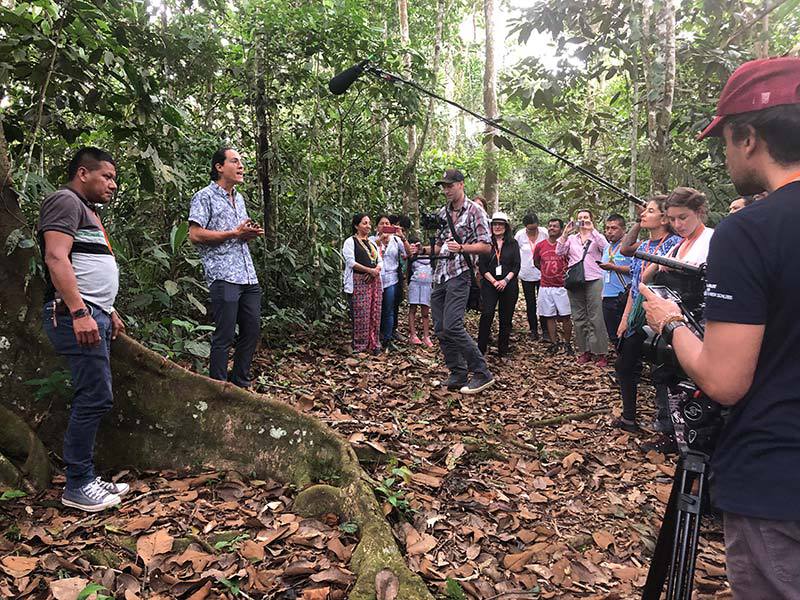
Ursula Biemann
Devenir University, Mocoa Meetings, 2018
Shooting in the forest.
The project is rooted in decolonizing education and environmental justice, and is a collective endeavor bringing together the indigenous communities of the region with University partners in Bogota and across the world. My long-term interest in the indigenous knowledge-producer finds a fertile terrain for ground testing here. It is not exactly a small project because once it is in full swing in a few years from now, the University is estimated to host up to 400 students. The faculty will include indigenous experts as well as academic staff, providing practice-based living experiences. Likewise, we don’t envision a compact campus architecture but a series of sites and nodes across the territory linked to river-learning, research gardens, language, medicinal plant knowledge, forest epistemologies. The entire program will emphasize environmental science, agroecology and ways of interacting with the living forest. Located next to a large unattended national park, the university could provide a great platform for international advanced students and researchers.
Together with the Inga education team and the support of an interdisciplinary Colombian team, we are developing a detailed concept now. Last year, I organized a kickoff meeting in the territory on the nature and purpose of this new institution. I’m now building an online audiovisual platform called “Devenir Universidad” which documents the amazing process of an indigenous territory becoming university. Eighteen months into the project I figured out what my role could be in this, apart from establishing partnerships. I decided that I could be most supportive by providing aesthetic and conceptual impulses to the indigenous-led initiative and by translating the issues and concepts for biocultural and multiepistemic communication through publications, exhibitions, video productions and a strong online presence. In other words, I see myself as an aesthetic companion to the project.
HG: Regarding those questions of situated or academic knowledge, I perceive in your work a very singular way of summoning scientific resources and hybridizing them with fiction and even science fiction to share contemporary intellectual issues with a wide audience. This fictional dimension is thus anchored in a set of very precise references, in current scientific and anthropological research that feeds in and opens up perspectives. I’m thinking in particular of the video Subatlantic in which the character of a scientist tells the story of the disappearance of glaciers and the consequences: the release of micro-organisms hitherto imprisoned, which mix their archaic DNA with today’s ecosystems. Based on current scientific observations and fields of research, you speculate, through the voice of your character, on the possible appearance of new species and the dynamics invisible to our eyes, potentially generating new interactions. You also evoke a singular relationship with time, the narrator referring to periods that go well beyond a human life. This recourse to fiction reminds me of Isabelle Stengers’ position, as someone who has long defended the importance of narrative, of stimulating the imagination to share and make intelligible scientific knowledge, and the importance of science fiction to envisage new perspectives and possibilities. Do you also consider that the territory of the imagination and the invention of narratives offer possible ways today to envisage new relationships to the world – and is this one of the sources of your transition to fiction? Can you also evoke how this shift to fiction took place? And finally, how do you inject the scientific contents that are sketched out, suggested by poetic and visual means? Is it the state of research that feeds fiction or do you have fiction issues that you link to your current research topic?
UB: When addressing the minuteness of water microbes or the overwhelming scale of an overheating climate, one obvious problem you encounter in aesthetic production is that many of these occurrences are unfolding in realms invisible to the human eye. A posthuman artistic practice, I figured, must therefore take place simultaneously on many scales. To grasp the subtle dimensions, I had to resort to semi-fictional narratives that can help to extend our limited sensorium and rational thought patterns by introducing speculative intelligence. So the fictions of the videos exploring the alterations in the chemical composition of the Earth, the atmosphere, and the oceans, all experiment with poetic narratives and science-fictional forms. It’s certainly no coincidence that the fictional figures I create are female natureculture tricksters expanding through millennia, having supernatural powers and communicating with the wind and all species. The colonization of others – be they women, indigenous peoples or natural beings – derives from one and the same logic. Hence the response and creation of visionary alternatives also emerges from that same position.
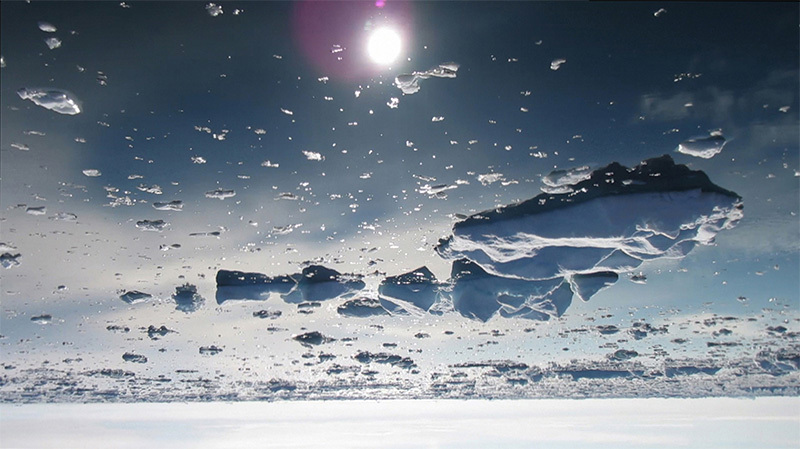
Ursula Biemann
Subatlantic, 2015
Imagination is obviously a vital process for worlding and thus in forging different kinds of relations to nature besides those of possession and extraction. The fictional characters in these works carrying the knowledge, they are transmitting scientific knowledge that is readily available. But it doesn’t stop at the reality that is tangible and measurable. Their knowledge also embraces thoughts, emotions, apprehensions, and psychic processes which merge with the landscape, with the Sea and the icescapes of Greenland. The poetic language I craft is meant to transport the viewer into these other dimensions, by perforating the scientific information with moments of rupture from rational logic. Creating these ruptures gives me great pleasure, I have to admit. But I also relish the findings of obscure scientific facts that give weight to the uncertainty of our planetary living conditions, as in the case you mentioned, of living microorganisms that have survived 400,000 years in the ice and are gradually entering the genetic pool of the world we live in. Science has never been as important as now, but it’s not enough to explain the data science produces. The images and narratives have to reach a collective imaginary, it has to go deeper than the rational mind. That’s why I intend to create landscapes that include the psychic, non-temporal dimensions.
HG: I would like to share with you a sentence from the science fiction author, Ursula K. Le Guin:
” Some of us out here in the wild oats, amid the alien corn, think we’d better start telling another one (Story), which maybe people can go on with when the old one’s finished. Maybe. The trouble is, we’ve all let ourselves become part of the killer story, and so we may get finished along with it. Hence it is with a certain feeling of urgency that I seek the nature, subject, words of the other story, the untold one, the life story.”1. This dimension is also very striking in your work, which you do not confine to a critical assessment of the state of the world. In each video you open up visions of the future, and you share alternative ways of living in the world, “new and more promising emerging worlds” as anthropologist Eduardo Kohn evokes: the cosmovision of indigenous peoples; interspecies communication and an ethic of relations with other species; the question of care and reparation etc. Do you recognize yourself in this search for “life story” as opposed to the “killer story”? And can you evoke this position consisting in opening new visions, which is a real change of perspective and a counterpoint to the Anthropocene discourse that has locked us in a state of astonishment and darkness since the early 2000s and particularly since 2012, the date of a major geological congress debating the relevance or otherwise of this new era?
UB: The Anthropocene as a concept was important in that it ripped us out of the short-term historical timeframe and propelled us into planetary timescales. I could literally feel how this idea blasted open a new way of perceiving our place in the world. On a more positive note, the Anthropocene—as a narrative and aesthetic device—has facilitated the emergence of new kinds of stories, importantly ones that bring the arts, humanities, and natural sciences into sharper mutual purview. But somehow the discourse got stuck too quickly in either glorifying the immense impact of humans on Earth through their technological ingenuity or harshly critiquing it. But either way, this doesn’t really help us imagine a different way of being in the world. You cannot critique and create at the same time. But cultivating a gentler vision for engaging the natural world is precisely what is most needed now. Not surprisingly, those who practice this kind of cosmovision – the indigenous peoples – are the ones who are under the greatest pressure. The extractive economy, the food industry, the legal system, the “killer story” is systemic, it permeates all areas of our society. To commit to “life stories” could simply consist in the conscious choice of propagating only life sustaining ideas that inspire ethical handling of all living things. But for writers and visual artists, this has always been the terrain for the most vivid imagination.
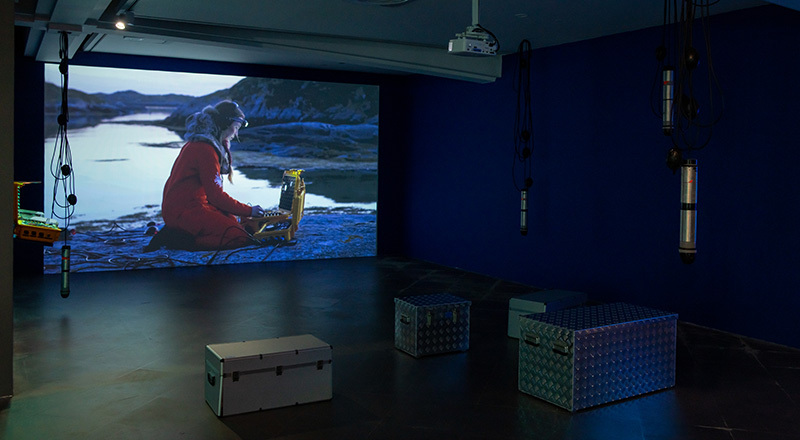
Ursula Biemann, Acoustic Ocean, 2018. Exhibition view « Ursula Biemann. Savoirs indigènes_Fictions cosmologiques », MAMAC, Nice, 2020, image Cécila Conan
HG: Going back to Acoustic Ocean, the Sami scientist is trying to capture the sounds emitted by creatures from the underwater depths and to communicate with them. The film introduces the idea – deeply rooted in indigenous cultures – of a continuity of relationships with all forms of life. A parallel is drawn between the fragility of the Sami way of life, the reindeer they live with and their ecosystem, and the great vulnerability of underwater creatures affected by all our forms of pollution (ocean acidification, sound emissions, underwater extraction). To use Donna Haraway’s expression, you suggest in your film a necessary “Devenir avec”. In her writings we find much of the idea that the scenarios of our future will only be possible if they are envisaged collectively and in an interspecies alliance between human and non-human. You explore in your recent works this vision and this call for a shift from an anthropocentric perception to a biocentric apprehension of the world, towards a form of awareness that we are part of a network of interactions with other forms of life. Could you develop your perspective and the way you deal with these issues? Do you plan to continue to explore them in future films?
UB: Artist, scholars, activists, we are all pushing now in this direction. It is the powerful writing and embodying of a posthumanism. Donna Haraway, as always, has been a pioneer in dismantling the autonomous human subject to reconfigure it as a being that is forming multiple and changing entities with other living communities and environments both natural and machinic. The Sami aquanaut in Acoustic Ocean is a living embodiment of this idea. She merges with the environment and, through her sensing techniques, reveals a sea full of intelligence. She is at once an indigenous woman wearing a traditional reindeer hood and a technologically equipped scientist in a deep sea diving suit. Haraway’s proposal is a major driver for all of these works and so is Astrida Neimanis’ posthumanist feminism in Bodies of Water, specifically for Acoustic Ocean.
My videos generally insist on intensifying interspecies communication because it places life at the center of what constitutes reality. This is what the biocentric lens means in the end. Artists can contribute to this shift in perspective by experimenting with a wide range of narrative and aesthetic forms that embody a more egalitarian political ecology and more horizontal multispecies relations. But the thematic focus doesn’t play out only on the level of the content, it also entails a shift in how I conceive my role as an artist. The imaginary characters I invent are interacting with earth, forests, and ocean creatures through sensing technologies. These science-fictional performers stand for a sensitive attitude of listening, caring, knowing, rather than authorial commenting, appropriating, or exploiting. This is just one of the ways in which a video artist can inspire a more ethical handling of all living beings.
Scientific research focuses mostly on what can be perceived with our senses, if necessary, by extending our sensorial limitations by technological instruments. But humans and as it turns out, other beings, are constantly broadcasting emotions, thoughts and psychic fields as an expression and extension of their selves, reaching into immaterial realms. My current research on the intelligence of nature seeks to understand these interrelations better by drawing on both scientific and shamanic forms of knowledge. For indigenous peoples in the Amazon, a vital force and spiritual energy permeate all that exists, both visible and invisible entities, endowing them with awareness and meaning. There is an innate intelligence in nature down to the molecular level. In Western science everything seems to point to a proliferation of objectifying practices in relation to nature, particularly in Colombia, my current research location and a veritable global hotspot of bioprospection. There, the forest is dismantled into small genetic exploitable data enabling a particularly rapacious version of scientific colonialism. In search of ways to open an inter-epistemic dialogue, my research focuses on approaches and exciting findings that are currently offered by more life supporting fields such as plant neurobiology, the anthropology of science, ethnobotany, and philosophies engaging with the life of plants. For this new video project I would have to film in the indigenous territories of the Colombian rainforest and I do hope that I can realize this trip next year.
Interview conducted in September 2020, in the frame of the exhibition “Ursula Biemann. Indigenous Knowledge_Cosmological Fictions”, MAMAC. Website of the artist: https://www.geobodies.org
Translation : Angela Kent for the English version and Stéphane Corcoral for the French version
Cover: Ursula Biemann, Acoustic Ocean, 2018.
1.Ursula K Le Guin, THE CARRIER BAG THEORY OF FICTION (1986)
